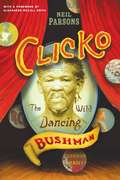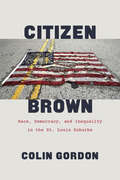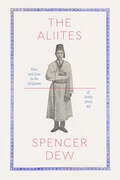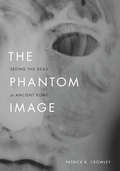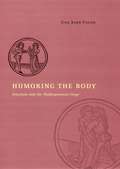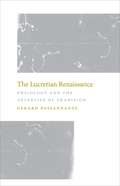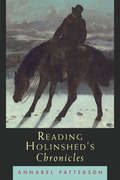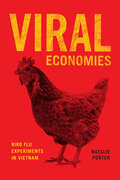- Table View
- List View
Clicko: The Wild Dancing Bushman
by Neil ParsonsDuring the 1920s and ’30s, Franz Taibosh—whose stage name was Clicko—performed in front of millions as one of the stars of the Ringling Brothers and Barnum & Bailey Circus. Prior to his fame in the United States, Taibosh toured the world as the “Wild Dancing Bushman,” showing off his frenzied dance moves in freak shows, sideshows, and music halls from Australia to Cuba. When he died in 1940, the New York Times called him “the only African bushman ever exhibited in this country.” In Clicko, Neil Parsons unearths the untold story of Taibosh’s journey from boyhood on a small farm in South Africa to top billing as one of the travelling World’s Fair Freaks. Through Taibosh’s tale, Parsons brings to life the bizarre golden age of entertainment as well as the role that the dubious new science of race played in it. Beginning with Taibosh’s early life, Clicko untangles the real story of his ancestry from the web of myths spun around him on his rise to international stardom. Parsons then chronicles the unhappy middle period of Taibosh’s career, when he suffered under the heel of a vicious manager. Left to freeze and nearly starve in an unheated apartment, Taibosh was rescued by Frank Cook, Barnum & Bailey’s lawyer. The Cooks adopted Taibosh as a member of their family of circus managers and performers, and his happy—if far from average—years with them make up the final chapter of this remarkable story. Equal parts entertaining and disturbing, Clicko vividly evokes a forgotten era when vaudeville drew massive crowds and circus freaks were featured in Billboard and Variety. Parsons introduces us to colorful characters such as George Auger the giant and the original Zip the Pinhead, but above all, he gives us an unforgettable portrait of Franz Taibosh, rescued at last from the racists and the romantics and revealed here as an ordinary man with an extraordinary life.
Citizen Brown: Race, Democracy, and Inequality in the St. Louis Suburbs
by Colin GordonThe 2014 killing of Michael Brown in Ferguson, Missouri, ignited nationwide protests and brought widespread attention police brutality and institutional racism. But Ferguson was no aberration. As Colin Gordon shows in this urgent and timely book, the events in Ferguson exposed not only the deep racism of the local police department but also the ways in which decades of public policy effectively segregated people and curtailed citizenship not just in Ferguson but across the St. Louis suburbs. Citizen Brown uncovers half a century of private practices and public policies that resulted in bitter inequality and sustained segregation in Ferguson and beyond. Gordon shows how municipal and school district boundaries were pointedly drawn to contain or exclude African Americans and how local policies and services—especially policing, education, and urban renewal—were weaponized to maintain civic separation. He also makes it clear that the outcry that arose in Ferguson was no impulsive outburst but rather an explosion of pent-up rage against long-standing systems of segregation and inequality—of which a police force that viewed citizens not as subjects to serve and protect but as sources of revenue was only the most immediate example. Worse, Citizen Brown illustrates the fact that though the greater St. Louis area provides some extraordinarily clear examples of fraught racial dynamics, in this it is hardly alone among American cities and regions. Interactive maps and other companion resources to Citizen Brown are available at the book website.
Citizen Brown: Race, Democracy, and Inequality in the St. Louis Suburbs
by Colin GordonThe 2014 killing of Michael Brown in Ferguson, Missouri, ignited nationwide protests and brought widespread attention police brutality and institutional racism. But Ferguson was no aberration. As Colin Gordon shows in this urgent and timely book, the events in Ferguson exposed not only the deep racism of the local police department but also the ways in which decades of public policy effectively segregated people and curtailed citizenship not just in Ferguson but across the St. Louis suburbs. Citizen Brown uncovers half a century of private practices and public policies that resulted in bitter inequality and sustained segregation in Ferguson and beyond. Gordon shows how municipal and school district boundaries were pointedly drawn to contain or exclude African Americans and how local policies and services—especially policing, education, and urban renewal—were weaponized to maintain civic separation. He also makes it clear that the outcry that arose in Ferguson was no impulsive outburst but rather an explosion of pent-up rage against long-standing systems of segregation and inequality—of which a police force that viewed citizens not as subjects to serve and protect but as sources of revenue was only the most immediate example. Worse, Citizen Brown illustrates the fact that though the greater St. Louis area provides some extraordinarily clear examples of fraught racial dynamics, in this it is hardly alone among American cities and regions. Interactive maps and other companion resources to Citizen Brown are available at the book website.
Citizen Brown: Race, Democracy, and Inequality in the St. Louis Suburbs
by Colin GordonThe 2014 killing of Michael Brown in Ferguson, Missouri, ignited nationwide protests and brought widespread attention police brutality and institutional racism. But Ferguson was no aberration. As Colin Gordon shows in this urgent and timely book, the events in Ferguson exposed not only the deep racism of the local police department but also the ways in which decades of public policy effectively segregated people and curtailed citizenship not just in Ferguson but across the St. Louis suburbs. Citizen Brown uncovers half a century of private practices and public policies that resulted in bitter inequality and sustained segregation in Ferguson and beyond. Gordon shows how municipal and school district boundaries were pointedly drawn to contain or exclude African Americans and how local policies and services—especially policing, education, and urban renewal—were weaponized to maintain civic separation. He also makes it clear that the outcry that arose in Ferguson was no impulsive outburst but rather an explosion of pent-up rage against long-standing systems of segregation and inequality—of which a police force that viewed citizens not as subjects to serve and protect but as sources of revenue was only the most immediate example. Worse, Citizen Brown illustrates the fact that though the greater St. Louis area provides some extraordinarily clear examples of fraught racial dynamics, in this it is hardly alone among American cities and regions. Interactive maps and other companion resources to Citizen Brown are available at the book website.
Citizen Brown: Race, Democracy, and Inequality in the St. Louis Suburbs
by Colin GordonThe 2014 killing of Michael Brown in Ferguson, Missouri, ignited nationwide protests and brought widespread attention police brutality and institutional racism. But Ferguson was no aberration. As Colin Gordon shows in this urgent and timely book, the events in Ferguson exposed not only the deep racism of the local police department but also the ways in which decades of public policy effectively segregated people and curtailed citizenship not just in Ferguson but across the St. Louis suburbs. Citizen Brown uncovers half a century of private practices and public policies that resulted in bitter inequality and sustained segregation in Ferguson and beyond. Gordon shows how municipal and school district boundaries were pointedly drawn to contain or exclude African Americans and how local policies and services—especially policing, education, and urban renewal—were weaponized to maintain civic separation. He also makes it clear that the outcry that arose in Ferguson was no impulsive outburst but rather an explosion of pent-up rage against long-standing systems of segregation and inequality—of which a police force that viewed citizens not as subjects to serve and protect but as sources of revenue was only the most immediate example. Worse, Citizen Brown illustrates the fact that though the greater St. Louis area provides some extraordinarily clear examples of fraught racial dynamics, in this it is hardly alone among American cities and regions. Interactive maps and other companion resources to Citizen Brown are available at the book website.
The Aliites: Race and Law in the Religions of Noble Drew Ali (Class 200: New Studies in Religion)
by Spencer Dew“Citizenship is salvation,” preached Noble Drew Ali, leader of the Moorish Science Temple of America in the early twentieth century. Ali’s message was an aspirational call for black Americans to undertake a struggle for recognition from the state, one that would both ensure protection for all Americans through rights guaranteed by the law and correct the unjust implementation of law that prevailed in the racially segregated United States. Ali and his followers took on this mission of citizenship as a religious calling, working to carve out a place for themselves in American democracy and to bring about a society that lived up to what they considered the sacred purpose of the law. In The Aliites, Spencer Dew traces the history and impact of Ali’s radical fusion of law and faith. Dew uncovers the influence of Ali’s teachings, including the many movements they inspired. As Dew shows, Ali’s teachings demonstrate an implicit yet critical component of the American approach to law: that it should express our highest ideals for society, even if it is rarely perfect in practice. Examining this robustly creative yet largely overlooked lineage of African American religious thought, Dew provides a window onto religion, race, citizenship, and law in America.
The Aliites: Race and Law in the Religions of Noble Drew Ali (Class 200: New Studies in Religion)
by Spencer Dew“Citizenship is salvation,” preached Noble Drew Ali, leader of the Moorish Science Temple of America in the early twentieth century. Ali’s message was an aspirational call for black Americans to undertake a struggle for recognition from the state, one that would both ensure protection for all Americans through rights guaranteed by the law and correct the unjust implementation of law that prevailed in the racially segregated United States. Ali and his followers took on this mission of citizenship as a religious calling, working to carve out a place for themselves in American democracy and to bring about a society that lived up to what they considered the sacred purpose of the law. In The Aliites, Spencer Dew traces the history and impact of Ali’s radical fusion of law and faith. Dew uncovers the influence of Ali’s teachings, including the many movements they inspired. As Dew shows, Ali’s teachings demonstrate an implicit yet critical component of the American approach to law: that it should express our highest ideals for society, even if it is rarely perfect in practice. Examining this robustly creative yet largely overlooked lineage of African American religious thought, Dew provides a window onto religion, race, citizenship, and law in America.
The Aliites: Race and Law in the Religions of Noble Drew Ali (Class 200: New Studies in Religion)
by Spencer Dew“Citizenship is salvation,” preached Noble Drew Ali, leader of the Moorish Science Temple of America in the early twentieth century. Ali’s message was an aspirational call for black Americans to undertake a struggle for recognition from the state, one that would both ensure protection for all Americans through rights guaranteed by the law and correct the unjust implementation of law that prevailed in the racially segregated United States. Ali and his followers took on this mission of citizenship as a religious calling, working to carve out a place for themselves in American democracy and to bring about a society that lived up to what they considered the sacred purpose of the law. In The Aliites, Spencer Dew traces the history and impact of Ali’s radical fusion of law and faith. Dew uncovers the influence of Ali’s teachings, including the many movements they inspired. As Dew shows, Ali’s teachings demonstrate an implicit yet critical component of the American approach to law: that it should express our highest ideals for society, even if it is rarely perfect in practice. Examining this robustly creative yet largely overlooked lineage of African American religious thought, Dew provides a window onto religion, race, citizenship, and law in America.
The Aliites: Race and Law in the Religions of Noble Drew Ali (Class 200: New Studies in Religion)
by Spencer Dew“Citizenship is salvation,” preached Noble Drew Ali, leader of the Moorish Science Temple of America in the early twentieth century. Ali’s message was an aspirational call for black Americans to undertake a struggle for recognition from the state, one that would both ensure protection for all Americans through rights guaranteed by the law and correct the unjust implementation of law that prevailed in the racially segregated United States. Ali and his followers took on this mission of citizenship as a religious calling, working to carve out a place for themselves in American democracy and to bring about a society that lived up to what they considered the sacred purpose of the law. In The Aliites, Spencer Dew traces the history and impact of Ali’s radical fusion of law and faith. Dew uncovers the influence of Ali’s teachings, including the many movements they inspired. As Dew shows, Ali’s teachings demonstrate an implicit yet critical component of the American approach to law: that it should express our highest ideals for society, even if it is rarely perfect in practice. Examining this robustly creative yet largely overlooked lineage of African American religious thought, Dew provides a window onto religion, race, citizenship, and law in America.
The Aliites: Race and Law in the Religions of Noble Drew Ali (Class 200: New Studies in Religion)
by Spencer Dew“Citizenship is salvation,” preached Noble Drew Ali, leader of the Moorish Science Temple of America in the early twentieth century. Ali’s message was an aspirational call for black Americans to undertake a struggle for recognition from the state, one that would both ensure protection for all Americans through rights guaranteed by the law and correct the unjust implementation of law that prevailed in the racially segregated United States. Ali and his followers took on this mission of citizenship as a religious calling, working to carve out a place for themselves in American democracy and to bring about a society that lived up to what they considered the sacred purpose of the law. In The Aliites, Spencer Dew traces the history and impact of Ali’s radical fusion of law and faith. Dew uncovers the influence of Ali’s teachings, including the many movements they inspired. As Dew shows, Ali’s teachings demonstrate an implicit yet critical component of the American approach to law: that it should express our highest ideals for society, even if it is rarely perfect in practice. Examining this robustly creative yet largely overlooked lineage of African American religious thought, Dew provides a window onto religion, race, citizenship, and law in America.
The Aliites: Race and Law in the Religions of Noble Drew Ali (Class 200: New Studies in Religion)
by Spencer Dew“Citizenship is salvation,” preached Noble Drew Ali, leader of the Moorish Science Temple of America in the early twentieth century. Ali’s message was an aspirational call for black Americans to undertake a struggle for recognition from the state, one that would both ensure protection for all Americans through rights guaranteed by the law and correct the unjust implementation of law that prevailed in the racially segregated United States. Ali and his followers took on this mission of citizenship as a religious calling, working to carve out a place for themselves in American democracy and to bring about a society that lived up to what they considered the sacred purpose of the law. In The Aliites, Spencer Dew traces the history and impact of Ali’s radical fusion of law and faith. Dew uncovers the influence of Ali’s teachings, including the many movements they inspired. As Dew shows, Ali’s teachings demonstrate an implicit yet critical component of the American approach to law: that it should express our highest ideals for society, even if it is rarely perfect in practice. Examining this robustly creative yet largely overlooked lineage of African American religious thought, Dew provides a window onto religion, race, citizenship, and law in America.
The Phantom Image: Seeing the Dead in Ancient Rome
by Patrick R. CrowleyDrawing from a rich corpus of art works, including sarcophagi, tomb paintings, and floor mosaics, Patrick R. Crowley investigates how something as insubstantial as a ghost could be made visible through the material grit of stone and paint. In this fresh and wide-ranging study, he uses the figure of the ghost to offer a new understanding of the status of the image in Roman art and visual culture. Tracing the shifting practices and debates in antiquity about the nature of vision and representation, Crowley shows how images of ghosts make visible structures of beholding and strategies of depiction. Yet the figure of the ghost simultaneously contributes to a broader conceptual history that accounts for how modalities of belief emerged and developed in antiquity. Neither illustrations of ancient beliefs in ghosts nor depictions of afterlife, these images show us something about the visual event of seeing itself. The Phantom Image offers essential insight into ancient art, visual culture, and the history of the image.
The Phantom Image: Seeing the Dead in Ancient Rome
by Patrick R. CrowleyDrawing from a rich corpus of art works, including sarcophagi, tomb paintings, and floor mosaics, Patrick R. Crowley investigates how something as insubstantial as a ghost could be made visible through the material grit of stone and paint. In this fresh and wide-ranging study, he uses the figure of the ghost to offer a new understanding of the status of the image in Roman art and visual culture. Tracing the shifting practices and debates in antiquity about the nature of vision and representation, Crowley shows how images of ghosts make visible structures of beholding and strategies of depiction. Yet the figure of the ghost simultaneously contributes to a broader conceptual history that accounts for how modalities of belief emerged and developed in antiquity. Neither illustrations of ancient beliefs in ghosts nor depictions of afterlife, these images show us something about the visual event of seeing itself. The Phantom Image offers essential insight into ancient art, visual culture, and the history of the image.
The Phantom Image: Seeing the Dead in Ancient Rome
by Patrick R. CrowleyDrawing from a rich corpus of art works, including sarcophagi, tomb paintings, and floor mosaics, Patrick R. Crowley investigates how something as insubstantial as a ghost could be made visible through the material grit of stone and paint. In this fresh and wide-ranging study, he uses the figure of the ghost to offer a new understanding of the status of the image in Roman art and visual culture. Tracing the shifting practices and debates in antiquity about the nature of vision and representation, Crowley shows how images of ghosts make visible structures of beholding and strategies of depiction. Yet the figure of the ghost simultaneously contributes to a broader conceptual history that accounts for how modalities of belief emerged and developed in antiquity. Neither illustrations of ancient beliefs in ghosts nor depictions of afterlife, these images show us something about the visual event of seeing itself. The Phantom Image offers essential insight into ancient art, visual culture, and the history of the image.
The Phantom Image: Seeing the Dead in Ancient Rome
by Patrick R. CrowleyDrawing from a rich corpus of art works, including sarcophagi, tomb paintings, and floor mosaics, Patrick R. Crowley investigates how something as insubstantial as a ghost could be made visible through the material grit of stone and paint. In this fresh and wide-ranging study, he uses the figure of the ghost to offer a new understanding of the status of the image in Roman art and visual culture. Tracing the shifting practices and debates in antiquity about the nature of vision and representation, Crowley shows how images of ghosts make visible structures of beholding and strategies of depiction. Yet the figure of the ghost simultaneously contributes to a broader conceptual history that accounts for how modalities of belief emerged and developed in antiquity. Neither illustrations of ancient beliefs in ghosts nor depictions of afterlife, these images show us something about the visual event of seeing itself. The Phantom Image offers essential insight into ancient art, visual culture, and the history of the image.
Humoring the Body: Emotions and the Shakespearean Stage
by Gail Kern PasterThough modern readers no longer believe in the four humors of Galenic naturalism—blood, choler, melancholy, and phlegm—early modern thought found in these bodily fluids key to explaining human emotions and behavior. In Humoring the Body, Gail Kern Paster proposes a new way to read the emotions of the early modern stage so that contemporary readers may recover some of the historical particularity in early modern expressions of emotional self-experience. Using notions drawn from humoral medical theory to untangle passages from important moral treatises, medical texts, natural histories, and major plays of Shakespeare and his contemporaries, Paster identifies a historical phenomenology in the language of affect by reconciling the significance of the four humors as the language of embodied emotion. She urges modern readers to resist the influence of post-Cartesian abstraction and the disembodiment of human psychology lest they miss the body-mind connection that still existed for Shakespeare and his contemporaries and constrained them to think differently about how their emotions were embodied in a premodern world.
Humoring the Body: Emotions and the Shakespearean Stage
by Gail Kern PasterThough modern readers no longer believe in the four humors of Galenic naturalism—blood, choler, melancholy, and phlegm—early modern thought found in these bodily fluids key to explaining human emotions and behavior. In Humoring the Body, Gail Kern Paster proposes a new way to read the emotions of the early modern stage so that contemporary readers may recover some of the historical particularity in early modern expressions of emotional self-experience. Using notions drawn from humoral medical theory to untangle passages from important moral treatises, medical texts, natural histories, and major plays of Shakespeare and his contemporaries, Paster identifies a historical phenomenology in the language of affect by reconciling the significance of the four humors as the language of embodied emotion. She urges modern readers to resist the influence of post-Cartesian abstraction and the disembodiment of human psychology lest they miss the body-mind connection that still existed for Shakespeare and his contemporaries and constrained them to think differently about how their emotions were embodied in a premodern world.
Humoring the Body: Emotions and the Shakespearean Stage
by Gail Kern PasterThough modern readers no longer believe in the four humors of Galenic naturalism—blood, choler, melancholy, and phlegm—early modern thought found in these bodily fluids key to explaining human emotions and behavior. In Humoring the Body, Gail Kern Paster proposes a new way to read the emotions of the early modern stage so that contemporary readers may recover some of the historical particularity in early modern expressions of emotional self-experience. Using notions drawn from humoral medical theory to untangle passages from important moral treatises, medical texts, natural histories, and major plays of Shakespeare and his contemporaries, Paster identifies a historical phenomenology in the language of affect by reconciling the significance of the four humors as the language of embodied emotion. She urges modern readers to resist the influence of post-Cartesian abstraction and the disembodiment of human psychology lest they miss the body-mind connection that still existed for Shakespeare and his contemporaries and constrained them to think differently about how their emotions were embodied in a premodern world.
The Lucretian Renaissance: Philology and the Afterlife of Tradition
by Gerard PassannanteWith The Lucretian Renaissance, Gerard Passannante offers a radical rethinking of a familiar narrative: the rise of materialism in early modern Europe. Passannante begins by taking up the ancient philosophical notion that the world is composed of two fundamental opposites: atoms, as the philosopher Epicurus theorized, intrinsically unchangeable and moving about the void; and the void itself, or nothingness. Passannante considers the fact that this strain of ancient Greek philosophy survived and was transmitted to the Renaissance primarily by means of a poem that had seemingly been lost—a poem insisting that the letters of the alphabet are like the atoms that make up the universe. By tracing this elemental analogy through the fortunes of Lucretius’s On the Nature of Things, Passannante argues that, long before it took on its familiar shape during the Scientific Revolution, the philosophy of atoms and the void reemerged in the Renaissance as a story about reading and letters—a story that materialized in texts, in their physical recomposition, and in their scattering. From the works of Virgil and Macrobius to those of Petrarch, Poliziano, Lambin, Montaigne, Bacon, Spenser, Gassendi, Henry More, and Newton, The Lucretian Renaissance recovers a forgotten history of materialism in humanist thought and scholarly practice and asks us to reconsider one of the most enduring questions of the period: what does it mean for a text, a poem, and philosophy to be “reborn”?
The Lucretian Renaissance: Philology and the Afterlife of Tradition
by Gerard PassannanteWith The Lucretian Renaissance, Gerard Passannante offers a radical rethinking of a familiar narrative: the rise of materialism in early modern Europe. Passannante begins by taking up the ancient philosophical notion that the world is composed of two fundamental opposites: atoms, as the philosopher Epicurus theorized, intrinsically unchangeable and moving about the void; and the void itself, or nothingness. Passannante considers the fact that this strain of ancient Greek philosophy survived and was transmitted to the Renaissance primarily by means of a poem that had seemingly been lost—a poem insisting that the letters of the alphabet are like the atoms that make up the universe. By tracing this elemental analogy through the fortunes of Lucretius’s On the Nature of Things, Passannante argues that, long before it took on its familiar shape during the Scientific Revolution, the philosophy of atoms and the void reemerged in the Renaissance as a story about reading and letters—a story that materialized in texts, in their physical recomposition, and in their scattering. From the works of Virgil and Macrobius to those of Petrarch, Poliziano, Lambin, Montaigne, Bacon, Spenser, Gassendi, Henry More, and Newton, The Lucretian Renaissance recovers a forgotten history of materialism in humanist thought and scholarly practice and asks us to reconsider one of the most enduring questions of the period: what does it mean for a text, a poem, and philosophy to be “reborn”?
The Lucretian Renaissance: Philology and the Afterlife of Tradition
by Gerard PassannanteWith The Lucretian Renaissance, Gerard Passannante offers a radical rethinking of a familiar narrative: the rise of materialism in early modern Europe. Passannante begins by taking up the ancient philosophical notion that the world is composed of two fundamental opposites: atoms, as the philosopher Epicurus theorized, intrinsically unchangeable and moving about the void; and the void itself, or nothingness. Passannante considers the fact that this strain of ancient Greek philosophy survived and was transmitted to the Renaissance primarily by means of a poem that had seemingly been lost—a poem insisting that the letters of the alphabet are like the atoms that make up the universe. By tracing this elemental analogy through the fortunes of Lucretius’s On the Nature of Things, Passannante argues that, long before it took on its familiar shape during the Scientific Revolution, the philosophy of atoms and the void reemerged in the Renaissance as a story about reading and letters—a story that materialized in texts, in their physical recomposition, and in their scattering. From the works of Virgil and Macrobius to those of Petrarch, Poliziano, Lambin, Montaigne, Bacon, Spenser, Gassendi, Henry More, and Newton, The Lucretian Renaissance recovers a forgotten history of materialism in humanist thought and scholarly practice and asks us to reconsider one of the most enduring questions of the period: what does it mean for a text, a poem, and philosophy to be “reborn”?
The Lucretian Renaissance: Philology and the Afterlife of Tradition
by Gerard PassannanteWith The Lucretian Renaissance, Gerard Passannante offers a radical rethinking of a familiar narrative: the rise of materialism in early modern Europe. Passannante begins by taking up the ancient philosophical notion that the world is composed of two fundamental opposites: atoms, as the philosopher Epicurus theorized, intrinsically unchangeable and moving about the void; and the void itself, or nothingness. Passannante considers the fact that this strain of ancient Greek philosophy survived and was transmitted to the Renaissance primarily by means of a poem that had seemingly been lost—a poem insisting that the letters of the alphabet are like the atoms that make up the universe. By tracing this elemental analogy through the fortunes of Lucretius’s On the Nature of Things, Passannante argues that, long before it took on its familiar shape during the Scientific Revolution, the philosophy of atoms and the void reemerged in the Renaissance as a story about reading and letters—a story that materialized in texts, in their physical recomposition, and in their scattering. From the works of Virgil and Macrobius to those of Petrarch, Poliziano, Lambin, Montaigne, Bacon, Spenser, Gassendi, Henry More, and Newton, The Lucretian Renaissance recovers a forgotten history of materialism in humanist thought and scholarly practice and asks us to reconsider one of the most enduring questions of the period: what does it mean for a text, a poem, and philosophy to be “reborn”?
Reading Holinshed's Chronicles (The\other Voice In Early Modern Europe Ser.)
by Annabel PattersonReading Holinshed's Chronicles is the first major study of the greatest of the Elizabethan chronicles. Holinshed's Chronicles—a massive history of England, Scotland, and Ireland—has been traditionally read as the source material for many of Shakespeare's plays or as an archaic form of history-writing. Annabel Patterson insists that the Chronicles be read in their own right as an important and inventive cultural history. Although we know it by the name of Raphael Holinshed, editor and major compiler of the 1577 edition, the Chronicles was the work of a group, a collaboration between antiquarians, clergymen, members of parliament, poets, publishers, and booksellers. Through a detailed reading, Patterson argues that the Chronicles convey rich insights into the way the Elizabethan middle class understood their society. Responding to the crisis of disunity which resulted from the Reformation, the authors of the Chronicles embodied and encouraged an ideal of justice, what we would now call liberalism, that extended beyond the writing of history into the realms of politics, law, economics, citizenship, class, and gender. Also, since the second edition of 1587 was called in by the Privy Council and revised under supervision, the work constitutes an important test case for the history of early modern censorship. An essential book for all students of Tudor history and literature, Reading Holinshed's Chronicles brings into full view a long misunderstood masterpiece of sixteenth-century English culture.
Viral Economies: Bird Flu Experiments in Vietnam
by Natalie PorterOver the last decade, infectious disease outbreaks have heightened fears of a catastrophic pandemic passing from animals to humans. From Ebola and bird flu to swine flu and MERS, zoonotic viruses are killing animals and wreaking havoc on the people living near them. Given this clear correlation between animals and viral infection, why are animals largely invisible in social science accounts of pandemics, and why do they remain marginal in critiques of global public health? In Viral Economies, Natalie Porter draws from long-term research on bird flu in Vietnam to chart the pathways of scientists, NGO workers, state veterinarians, and poultry farmers as they define and address pandemic risks. Porter argues that as global health programs expand their purview to include life and livestock, they weigh the interests of public health against those of commercial agriculture, rural tradition, and scientific innovation. Porter challenges human-centered analyses of pandemics and shows how dynamic and often dangerous human-animal relations take on global significance as poultry and their pathogens travel through global livestock economies and transnational health networks. Viral Economies urges readers to think critically about the ideas, relationships, and practices that produce our everyday commodities, and that shape how we determine the value of life—both human and nonhuman.
Viral Economies: Bird Flu Experiments in Vietnam
by Natalie PorterOver the last decade, infectious disease outbreaks have heightened fears of a catastrophic pandemic passing from animals to humans. From Ebola and bird flu to swine flu and MERS, zoonotic viruses are killing animals and wreaking havoc on the people living near them. Given this clear correlation between animals and viral infection, why are animals largely invisible in social science accounts of pandemics, and why do they remain marginal in critiques of global public health? In Viral Economies, Natalie Porter draws from long-term research on bird flu in Vietnam to chart the pathways of scientists, NGO workers, state veterinarians, and poultry farmers as they define and address pandemic risks. Porter argues that as global health programs expand their purview to include life and livestock, they weigh the interests of public health against those of commercial agriculture, rural tradition, and scientific innovation. Porter challenges human-centered analyses of pandemics and shows how dynamic and often dangerous human-animal relations take on global significance as poultry and their pathogens travel through global livestock economies and transnational health networks. Viral Economies urges readers to think critically about the ideas, relationships, and practices that produce our everyday commodities, and that shape how we determine the value of life—both human and nonhuman.
